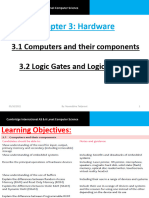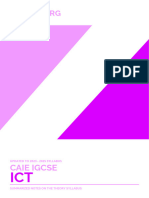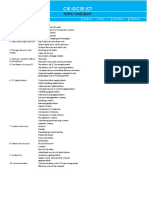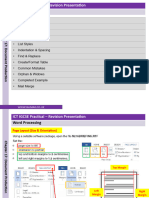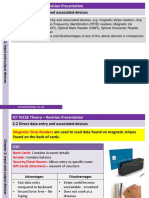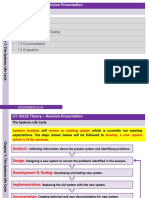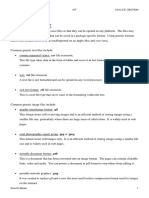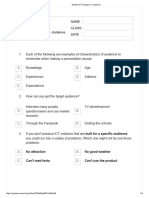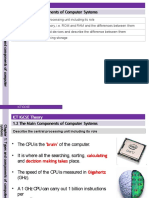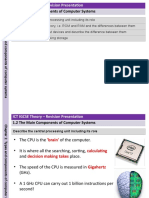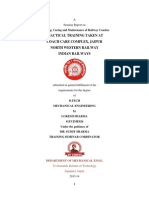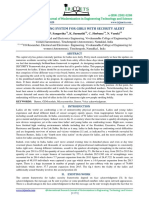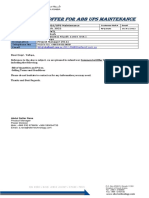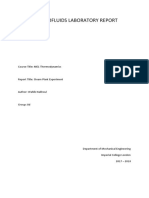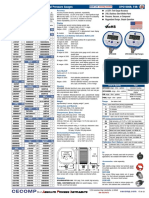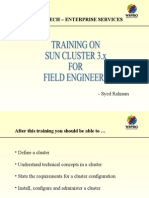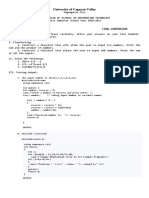ICT IGCSE Theory – Revision Presentation
1.2 The Main Components of Computer Systems
Chapter 1: Types and components of computer systems
• Describe the central processing unit including its role
• Describe internal memory, i.e. ROM and RAM and the differences between them
• Define input and output devices and describe the difference between them
• Define secondary/backing storage
WWW.YAHMAD.CO.UK
� ICT IGCSE Theory – Revision Presentation
1.2 The Main Components of Computer Systems
Chapter 1: Types and components of computer systems
Describe the central processing unit including its role
• The CPU is the 'brain' of the computer.
• It is where all the searching, sorting, calculating
and decision making takes place.
• The speed of the CPU is measured in Gigahertz
(GHz).
• A 1 GHz CPU can carry out 1 billion instructions per
second!
• Intel and AMD are the most popular CPU brands.
WWW.YAHMAD.CO.UK
� ICT IGCSE Theory – Revision Presentation
1.2 The Main Components of Computer Systems
Chapter 1: Types and components of computer systems
Main Memory
Applications are installed in the Secondary Storage (Hard drive).
Temporary data from Applications in use are held in the Main Memory.
The CPU will first check the Cache for the required piece of the data so that it can
be processed.
If the data is not in the cache then the CPU will check the RAM and transfer data to
the CPU.
The Cache will then transfer the next piece of data from the RAM into Cache.
The CPU will again check the Cache for the next piece of data. This time the CPU will
be able to get the data from the Cache Memory.
WWW.YAHMAD.CO.UK
� ICT IGCSE Theory – Revision Presentation
1.2 The Main Components of Computer Systems
Chapter 1: Types and components of computer systems
Main Memory
WWW.YAHMAD.CO.UK
� ICT IGCSE Theory – Revision Presentation
1.2 The Main Components of Computer Systems
Chapter 1: Types and components of computer systems
Cache
• Cache is the fastest type of Memory.
• It is located between the processor and the RAM.
• Cache collects data from the RAM.
• Holds onto commonly used data.
• The Cache will automatically transfer the next set
of data from the RAM in to the Cache so that it
can be processed by the CPU.
WWW.YAHMAD.CO.UK
� ICT IGCSE Theory – Revision Presentation
1.2 The Main Components of Computer Systems
Chapter 1: Types and components of computer systems
RAM (Random Access Memory)
• RAM stands for Random Access Memory
• RAM is the part of the computer that temporarily
stores the instructions that the computer is
running whilst the data is being processed by the
CPU.
• RAM is volatile which means that when the
computer is turned off all data is lost
WWW.YAHMAD.CO.UK
� ICT IGCSE Theory – Revision Presentation
1.2 The Main Components of Computer Systems
Chapter 1: Types and components of computer systems
ROM (Read Only Memory)
• ROM stands for Read Only Memory
• ROM is a built in memory that can not be changed
(Read Only).
• ROM normally holds the ‘boot up’ instructions to
start the computer – without it the computer
wouldn’t know what to do when on button is
switched on (e.g. the operating system will not
start).
• ROM is non-volatile memory which means that
memory is not lost when computer is turned off.
WWW.YAHMAD.CO.UK
� ICT IGCSE Theory – Revision Presentation
1.2 The Main Components of Computer Systems
Chapter 1: Types and components of computer systems
Describe the difference between the Cache, RAM & ROM?
Cache RAM ROM (Read only memory)
Fastest, CPU, Common Data Temporary data, volatile (data
Read Only, Bootup & Non-
lost on startup)
volatile (Data not lost)
Exam Question
The Cache memory is the fastest type of memory. It is located between the CPU and
RAM. It holds commonly used data. RAM (Random Access Memory) is a volatile
type of memory which means all data is lost on startup. In contrast ROM (Read Only
Memory) is non-volatile which means data is not lost on startup. The ROM memory
is Read Only and contains boot up instructions. The RAM memory hold temporary
data which is processed by the CPU.
WWW.YAHMAD.CO.UK
� ICT IGCSE Theory – Revision Presentation
1.2 The Main Components of Computer Systems
Chapter 1: Types and components of computer systems
Input and Output devices
Devices need to be connected to a computer to allow data to be inputted and
outputted.
The general name for these extra devices is ‘peripheral devices’. They are usually
categorised into input devices, output devices and storage devices.
Input Output Storage
An input device is a device that can pass date into the computer
Devices that take data from the computer are known as output devices.
WWW.YAHMAD.CO.UK
� ICT IGCSE Theory – Revision Presentation
1.2 The Main Components of Computer Systems
Chapter 1: Types and components of computer systems
Define secondary/backing storage
Backing storage is also known as secondary storage
Backing storage is non-volatile which means that
data is not lost when computer is turned off.
Backing storage is used to store data for a long time
(data can be read from and written to)
Users tend to make copies of original files on
backing storage.
WWW.YAHMAD.CO.UK
� ICT IGCSE Theory – Revision Presentation
1.2 The Main Components of Computer Systems
Chapter 1: Types and components of computer systems
Describe what is backing storage (secondary storage)?
Key Words: non-volatile, data, long time, Read, Write &
copies
Exam Question
Backing storage also known as secondary storage is non-volatile which means that data
is not lost when computer is turned off. An example of backing storage is a fixed hard
drive. Data is stored for a long time and can be accessed at any point (Read and write).
Users tend to make copies of original files on backing storage.
WWW.YAHMAD.CO.UK
